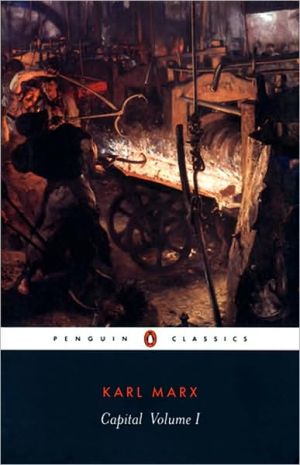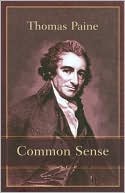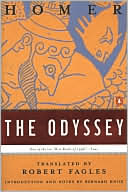Capital: A Critique of Political Economy, Vol. 1
This 1867 study—one of the most influential documents of modern times—looks at the relationship between labor and value, the role of money, and the conflict between the classes.\ \ \ One of Marx's major and most influential works was the product of 30 years close study of the capitalist mode of production in England.\
Search in google:
Das Kapital, Karl Marx's masterwork, is the book that above all others formed the twentieth century. From Kapital sprung the economic and political systems that in our time dominated half the earth and for half a century kept the world on the brink of war. Even today, one billion Chinese remain in the power of the Marxist system. Yet this important and powerful work has been passed over by many readers frustrated by Marx's difficult style and his preoccupation with nineteenth-century events of little relevance to today's reader. Now Serge Levitsky presents a new revised version of this masterpiece, carefully retranslated for the modern reader and abridged to emphasize the political and philosophical core of Marx's work, while trimming away much that is now unimportant. Here then is a fresh and highly readable version of a work whose ideas have influenced the lives of nearly every person alive today.
Capital Introduction by Ernest Mandel Translator's Preface Preface to the First Edition Postface to the Second Edition Preface to the French Edition Postface to the French Edition Preface to the Third Edition (by Engels)\ Preface to the English Edition (by Engels)\ Preface to the Fourth Edition (by Engels)\ BOOK I: THE PROCESS OF PRODUCTION OF CAPITAL\ Part One: Commodities and Money\ Chapter 1: The Commodity\ 1. The Two Factors of the Commodity: Use-Value and Value (Substance of VAlue, Magnitude of Value)\ 2. The Dual Character of the Labour Embodied in Commodities\ 3. The Value-Form, or Exchange-Value\ (a) The Simple, Isolated, or Accidental Form of Value\ (1) The two poles of the expression of value: the relative form of value and the equivalent form\ (2) The relative form of value\ (i) The content of the relative form of value\ (ii) The quantitative determinacy of the relative form of value\ (iii) The equivalent form\ (iv) The simple form of value considered as a whole\ (b) The Total or Expanded Form of Value\ (1) The expanded relative form of value\ (2) The particular equivalent form\ (3) Defects of the total or expanded form of value\ (c) The General Form of Value\ (1) The changed character of the form of value\ (2) The development of the relative and equivalent forms of value: their interdependence\ (3) The transition from the general form of value to the money form\ (d) The Money Form\ 4. The Fetishism of the Commodity and Its Secret\ Chapter 2: The Process of Exchange\ Chapter 3: Money, or the Circulation of Commodities\ 1. The Measure of Values\ 2. The Means of Circulation\ (a) The Metamorphosis of Commodities\ (b) The Circulation of Money\ (c) Coin. The Symbol of Value\ 3. Money\ (a) Hoarding\ (b) Means of Payment\ (c) World Money\ PART TWO: THE TRANSFORMATION OF MONEY INTO CAPITAL\ Chapter 4: The General Formula for Capital\ Chapter 5: Contradictions in the General Formula\ Chapter 6: The Sale and Purchase of Labour-Power\ PART THREE: THE PRODUCTION OF ABSOLUTE SURPLUS-VALUE\ Chapter 7: The Labour Process and the Valorization Process\ 1. The Labour Process\ 2. The Valorization Process\ Chapter 8: Constant Capital and Variable Capital\ Chapter 9: The Rate of Surplus-Value\ 1. The Degree of Exploitation of Labour-Power\ 2. The Representation of the Value of the Product by Corresponding Proportional Parts of the Product\ 3. Senior's "Last Hour"\ 4. The Surplus Product\ Chapter 10: The Working Day\ 1. The Limits of the Working Day\ 2. The Voracious Appetite for Surplus Labour. Manufacturer and Boyar\ 3. Branches of English Industry without Legal Limits to Exploitation\ 4. Day Work and Night Work. The Shift System\ 5. The Struggle for a Normal Working Day. Laws for the Compulsory Extension of the Working Day, from the Middle of the Fourteenth to the End of the Seventeenth Century\ 6. The Struggle for a Normal Working Day. Laws for the Compulsory Limitation of Working Hours. The English Factory Legislation of 1833-64\ 7. The Struggle for a Normal Working Day. Impact of the English Factory Legislation on Other Countries\ Chapter 11: The Rate and Mass of Surplus-Value\ PART FOUR: THE PRODUCTION OF RELATIVE SURPLUS-VALUE\ Chapter 12: The Concept of Relative Surplus-Value\ Chapter 13: Co-operation\ Chapter 14: The Division of Labour and Manufacture\ 1. The Dual Origin of Manufacture\ 2. The Specialized Worker and His Tools\ 3. The Two Fundamental Forms of Manufacture - Heterogeneous and Organic\ 4. The Division of Labour in Manufacture, and the Division of Labour in Society\ 5. The Capitalist Character of Manufacture\ Chapter 15: Machinery and Large-Scale Industry\ 1. The Development of Machinery\ 2. The Value Transferred by the Machinery to the Product\ 3. The Most Immediate Effects of Machine Production on the Worker\ (a) Appropriation of Supplementary Labour-Power by Capital. The Employment of Women and Children\ (b) The Prolongation of the Working Day\ (c) Intensification of Labour\ 4. The Factory\ 5. The Struggle between Worker and Machine\ 6. The Compensation Theory, with Regard to the Workers Displaced by Machinery\ 7. Repulsion and Attraction of Workers through the Development of Machine Production. Crises in the Cotton Industry\ 8. The Revolutionary Impact of Large-Scale Industry on Manufacture, Handicrafts and Domestic Industry\ (a) Overthrow of Co-operation Based on Handicrafts and on the Division of Labour\ (b) The Impact of the Factory System on Manufacture and Domestic Industries\ (c) Modern Manufacture\ (d) Modern Domestic Industry\ (e) Transition from Modern Manufacture and Domestic Industry to Large-Scale Industry. The Hastening of this Revolution by the Application of the Factory Acts to those Industries\ 9. The Health and Education Clauses of the Factory Acts. The General Extension of Factory Legislation in England\ 10. Large-Scale Industry and Agriculture\ PART FIVE: THE PRODUCTION OF ABSOLUTE AND RELATIVE SURPLUS-VALUE\ Chapter 16: Absolute and Relative Surplus-Value\ Chapter 17: Changes of Magnitude in the Price of Labour-Power and in Surplus-Value\ 1. The Length of the Working Day and the Intensity of Labour Constant; the Productivity of Labour Variable\ 2. The Length of the Working Day and the Productivity of Labour Constant; the Intensity of Labour Variable\ 3. The Productivity and Intensity of Labour Constant; the Length of the Working Day Variable\ 4. Simultaneous Variations in the Duration, Productivity and Intensity of Labour\ Chapter 18: Different Formulae for the Rate of Surplus-Value\ PART SIX: WAGES\ Chapter 19: The Transformation of the Value (and Respectively the Price) of Labour-Power into Wages\ Chapter 20: Time-Wages\ Chapter 21: Piece-Wages\ Chapter 22: National Differences in Wages\ PART SEVEN: THE PROCESS OF ACCUMULATION OF CAPITAL\ Chapter 23: Simple Reproduction\ Chapter 24: The Transformation of Surplus-Value into Capital\ 1. Capitalist Production on a Progressively Increasing Scale. The Inversion which Converts the Property Laws of Commodity Production into Laws of Capitalist Appropriation\ 2. The Political Economists' Erroneous Conception of Reproduction on an Increasing Scale\ 3. Division of Surplus-Value into Capital and Revenue. The Abstinence Theory\ 4. The Circumstances which, Independently of the Proportional Division of Surplus-Value into Capital and Revenue, Determine the Extent of Accumulation, namely, the Degree of Exploitation of Labour-Power, the Productivity of Labour, the Growing Difference in Amount between Capital Employed and Capital Consumed, and the Magnitude of the Capital Advanced\ 5. The So-Called Labour Fund\ Chapter 25: The General Law of Capitalist Accumulation\ 1. A Growing Demand for Labour-Power Accompanies Accumulation if the Composition of Capital Remains the Same\ 2. A Relative Diminution of the Variable Part of Capital Occurs in the Course of the Further Progress of Accumulation and of the Concentration Accompanying It\ 3. The Progressive Reduction of a Relative Surpluse Population or Industrial Reserve Army\ 4. Different Forms of Existence of the Relative Surplus Population. The General Law of Capitalist Accumulation\ 5. Illustrations of the General Law of Capitalist Accumulation\ (a) England from 1846 to 1866\ (b) The Badly Paid Strata of the British Industrial Working Class\ (c) The Nomadic Population\ (d) Effect of Crises on the Best Paid Section of the Working Class\ (e) The British Agricultural Proletariat\ (f) Ireland\ PART EIGHT: SO-CALLED PRIMITIVE ACCUMULATION\ Chapter 26: The Secret of Primitive Accumulation\ Chapter 27: The Expropriation of the Agricultural Population from the Land\ Chapter 28: Bloody Legislation against the Expropriated since the End of the Fifteenth Century. The Forcing Down of Wages by Act of Parliament\ Chapter 29: The Genesis of the Capitalist Farmer\ Chapter 30: Impact of the Agricultural Revolution on Industry. The Creation of a Home Market for Industrial Capital\ Chapter 31: The Genesis of the Industrial Capitalist\ Chapter 32: The Historical Tendency of Capitalist Accumulation\ Chapter 33: The Modern Theory of Colonization\ Appendix: Results of the Immediate Process of Production\ Introduction by Ernest Mandel I. Commodities as the Product of Capital II. Capitalist Production as the Production of Surplus-Value III. Capitalist Production is the Production and Reproduction of the Specifically Capitalist Relations of Production IV. Isolated Fragments\ Quotations in Languages Other than English and German Index of Authorities Quoted General Index Note on Previous Editions of the Works of Marx and Engels Chronology of Works by Marx and Engels








